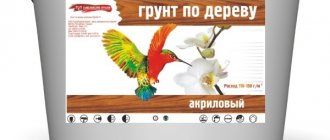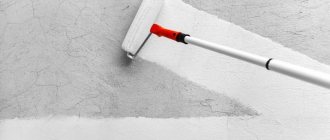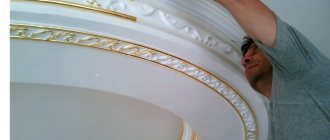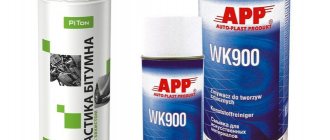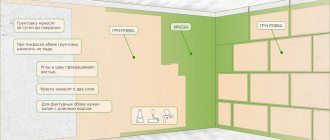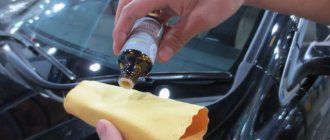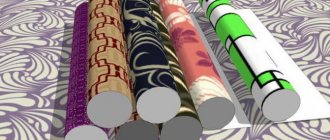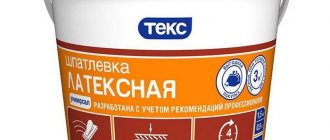Traditional materials for wall decoration are known to almost everyone. But technology does not stand still and new materials are appearing. One of them is fiberglass. They began to use it for painting, as it has excellent reinforcing properties. This is an innovative material that is increasingly used in interior decoration.
What is fiberglass for painting?
Fiberglass is a non-woven fabric that is sold in rolls. It is made from the smallest glass fibers when they are pressed. In some ways the material resembles ordinary wallpaper. Only the structure of the product is different. The fabric is very thin and translucent. Due to this feature, the material has another name - painting web. The finest glass fibers are intertwined in a chaotic manner and firmly connected to each other thanks to the adhesive composition. It is made on the basis of organic resins. The main raw material for fiberglass is quartz sand.
Painting web is sold in rolls. It contains 50 m of material, 1 m wide. Density from 25 to 50 g/m2. The choice depends on the application. You can choose a lower density for the ceiling, and a higher density for the walls. The web is produced in order to prepare the surface for final finishing. With it you can avoid cracks on the walls, and also level the walls without using plaster. The cobweb is a reinforcing layer; with it, a wall or ceiling will retain its original beautiful appearance for decades. In this case, there is no need to mask the cracks that appear. Fiberglass is fixed to the walls with special glue. And then all that remains is to paint the wall or stick wallpaper. It does not matter what base is used and in what wall.
What is it needed for
Fiberglass is a non-woven material designed for leveling surfaces. The canvas resembles a finely woven cobweb, which is why it is called “painting cobweb” in the professional sphere.
The canvas is obtained by pressing a mixture of quartz sand and adhesive. It looks like weaving thin glass fibers. At first glance, it is completely unclear how a translucent sheet can simplify finishing. But this is just an illusion.
Expert opinion
Mezentsev Sergey Petrovich
Residential renovation and finishing specialist
The fiberglass acts as a reinforcing element. Its ductility is so high that it can easily withstand surface deformations of varying degrees.
Thanks to him, it is possible to achieve the following effects:
- masking and preventing the aggravation of existing cracks and irregularities;
- prevention of cracking and chipping;
- protection against destruction in seismically unfavorable regions;
- simplification of shrinkage in new buildings;
- extending the life of walls and paintwork under conditions of frequent changes in humidity and temperature;
- surface texture leveling;
- reducing paint consumption, ensuring its better distribution;
- increasing fire resistance;
- preventing dust absorption.
All of the above is true for both walls and ceilings. As a result, the appearance of the room becomes as sleek as possible.
Application area
Cobweb is a universal material. It helps eliminate visual unevenness and other wall defects. It is possible to glue fiberglass to plasterboard, concrete, plaster, wood, etc. The premises are residential or utility – it doesn’t matter.
The canvases are used to prepare the bedroom, home library, bathroom, living room, corridor, office, hallway. Fiberglass is also relevant for the construction of drainage holes, for creating a waterproofing layer, for the construction of wall panels or floor cladding, on the roof and in the manufacture of mastic. This is not in vain, since the material can extend the life of metal pipes and protect surfaces.
List of product brands that are available on the Russian market:
- Wellton and Oscar from Sweden and Germany;
- Finnish FitGlass, Holtex, FinTex;
- Nortex from Holland;
- GM Glassmaster from Germany;
- “Esta”, IN-TEX – Czech Republic;
- Swedish Swedtex;
- Schuller, Baumax, Vitrulan from Germany.
You can use fiberglass for walls for painting at temperature fluctuations from -40 to +60 degrees.
Advantages and disadvantages
In addition to the above features, the material has the following advantages:
- Vapor permeable. No condensation will form inside. In order not to lose this advantage, the paint for fiberglass should also be like this.
- It is antistatic, does not electrify and does not attract dust.
- Safe and will not harm the health of residents.
- Hypoallergenic.
- Not afraid of fire, does not support combustion.
- Has an affordable price.
- Suitable for coloring.
Even a beginner can work with the material. True, the process is performed very carefully. During operation, small particles of glass may break off from the canvas. They get into the eyes, mucous membranes and skin, causing irritation and other negative consequences. You need to work on defense.
Advantages and disadvantages
Fiberglass has both positive and negative sides.
Pros:
- fire safety;
- environmental friendliness;
- hypoallergenic;
- vapor permeability;
- resistance to mold and fungi;
- no static electricity;
- durability;
- can be glued locally, in pieces;
- reusable, does not require dismantling when updating paint or wallpaper;
- different prices from different manufacturers, you can choose an affordable option for yourself.
Minuses:
- difficulty in cutting;
- may dig into hands, causing irritation;
- dangerous for the respiratory system during operation.
All imperfections are due to the texture of the material. The fiber crumbles easily. Therefore, safety precautions must be strictly observed until finishing is completed. You will need to use a respirator, gloves, goggles and closed clothing.
After manipulations, be sure to shake off things and take a shower. If particles get into your eyes or nasopharynx, you should immediately seek medical help.
Types of fiberglass
There are 3 types of painting web available on the market:
- Ceiling. It has a low density, only 25 g/m2. In this case, 1 m2 of canvas will weigh 25 g. It is used for gluing to the ceiling and further painting. At the same time, the consumption of paint and varnish material is reduced. But, this option is suitable for perfectly smooth surfaces without cracks.
- Universal web, density 40 g/m2. The cost is optimal. This fiberglass is used for walls or similar surfaces that are subject to mechanical stress. Can be glued to ceilings with loose plaster or high vibration load.
- Dense web 50 g/m2. Hides large cracks. Able to withstand significant mechanical stress. Suitable for industrial buildings such as garages, workshops, warehouses. The price of fiberglass is higher, as is the cost of installation work. The weight is large, more glue is needed.
Advice ! When working with any type of product, it is important to adhere to safety precautions. Overalls that cover the skin, goggles and a respirator.
Fiberglass and glass wallpaper: the same thing?
This confusion occurs quite often. For an unprepared person, it may seem that we are talking about the same material. But the concepts have fundamental differences.
First of all, the difference lies in the production method. The canvases are pressed chaotically, no one monitors the direction of the fiber, only the density is observed. Wallpaper resembles fabric. They are literally woven using special equipment, creating an orderly weave.
The canvases turn out to look like paper sheets. Their surface is smooth. Wallpaper has some pattern, like fabric.
The second striking difference is density. Fiberglass wallpaper is produced with indicators from 150 to 225 g/sq.m. they do not crumble and do not irritate your hands. This determines the final purpose of the option.
Such canvases do not even need to be painted, although they certainly perform a strengthening function. At the same time, unlike fiberglass, they cannot be repainted many times. The texture will become thinner and begin to break down.
Gluing canvases to the wall
How to glue fiberglass to a ceiling or walls for painting? It is necessary to carry out the process at a temperature from +17 to 25 degrees, with a humidity of no more than 60%. Direct sunlight and drafts are unacceptable. The rest of the process is step by step:
- Inspection of the treated surface. Impressive chips and potholes need to be filled with putty. Both putty and plaster will do.
- Remove all dirt, dust and stains.
- Apply primer to improve adhesion. It must be a deep-penetrating composition in order to structure the surface, fill cavities and improve adhesion. Wait for it to dry, the time indicated on the package.
- Next you can glue the fiberglass. It is difficult to fix the whole canvas, so it is better to cut it into convenient strips. Allowances are made along the edges (10–20 mm).
- Prepare glue for fiberglass according to the instructions on the package. Applying the substance to the back of the web. The edges are processed with special care. It is important to evenly distribute the glue over the canvas, in a layer of no more than 1 mm.
- Fixation on gypsum plasterboard (plasterboard) or other surfaces is practically the same. Work starts from the corner. In some ways the process is reminiscent of wallpapering. The canvas is straightened out so that wrinkles do not form. After fixing the first fiberglass, the next strip is glued. It is fixed with an overlap of 10–20 cm. After the glue hardens, it should be trimmed.
- The joints are a weak point, so they need to be additionally impregnated with adhesive.
The room is left for 2 days for the glue to dry. After that all that remains is to putty the surface. But that's not all, all that remains is to do the coloring.
Cutting and gluing the first canvas
When unfolding rolls, you should pay attention to the manufacturer’s instructions on where the front part is located. It makes a difference even though both parts look the same.
The edge will have to be cut off a little with scissors if the edges of the fabric are curled or damaged.
Apply glue liberally to the prepared surface with a roller or spatula (the width of the roll). When in contact with the canvas, the glue will quickly absorb and there will be no excess that will need to be removed. The glue dries for about 15 minutes, this is enough time to adjust the first canvas.
You can cut the canvas to any length, the main thing is that it is convenient. But if for walls the length can be solid, to the entire height (plus 5 cm), then for the ceiling it is necessary to cut off pieces of one and a half meters. Otherwise, it will be inconvenient to work, and the canvas will not stick well.
You need to work from the corner of the room. Applying it to the coated surface, smooth it with your hands, aligning it with the corner, and spread the glue under the canvas with a spatula, removing air bubbles. The standard technique is from the middle to the edge, as is done with regular wallpaper. It is better to glue sheets on the ceiling along the room from the door to the window.
So, the sheet has stuck securely to the surface. You need to cut off excess centimeters if they have “formed” and coat the top with glue again for better impregnation, spreading it with a spatula. If the canvas darkens evenly from the moisture of the glue, it means that it is well saturated.
How to paint fiberglass
Painting fiberglass is a simple process. First you need to choose a paint material. List of the best:
- Water emulsion;
- Acrylic based paint;
- Silicone composition;
- Latex paint.
Is it possible to paint fiberglass without putty? Yes, only in this case you need to apply several layers and choose a thick paint. You cannot apply two layers at once; it is important to wait for the previous one to dry. If you do not follow the technology, the paint may peel off or fail earlier.
Painting of fiberglass is done with a brush and roller. Corners and hard-to-reach places are painted with a brush. A roller will help with the rest. With it the layer will turn out smooth and beautiful. In addition, the work goes quickly, and paint consumption will be reduced. It is poured into the roller tray. The tool is dipped into paint and rolled over the surface of the tray. You need to paint from top to bottom, using vertical movements.
Advice! It is better not to use a foam roller; it may crumble. A tool with bristles will do.
Painting fiberglass without putty is acceptable, but it is better to putty the surface. This will help eliminate all minor defects, the texture of the fiberglass will not show through, and will reduce paint consumption. After all, fiberglass absorbs paint and varnish material well. And tastes change, so someone will want to change the paint on the wallpaper. It's easier to do this with a layer of putty.
Characteristics of Oscar glue for fiberglass
According to numerous reviews, it is better to glue fiberglass with Oskar, a water-dispersed acrylic adhesive that contains PVA, latex, modified starch and antiseptic additives. The glue can be presented in the form of a dry powder, which is easily diluted with cold water without forming lumps, or a ready-made composition.
The finished mixture is frost-resistant, so it can be stored at a temperature of 50 ° C for 1 month. After the 5th defrosting, the composition will not be suitable for use. Ready-made glue is produced in buckets with a capacity of 5 and 10 liters. Stored unopened for up to 3 years. You can buy glue for Oskar fiberglass from 500 rubles. The dry composition is stored for up to 2 months. It is produced in bags of 1 and 10 kg, cardboard packages weighing 200 and 400 g. The cost of the smallest packaging is about 200 rubles.
The product is applied to the surface to be decorated. Thanks to the elastic base, the position of the canvas can be easily adjusted until the glue dries. The mixture contains antiseptic additives that prevent the formation of mold, mildew and pathogens. The composition is environmentally friendly. It has no odor, is a non-flammable, non-flammable, explosion-proof mixture. The glue has good breathability.
Oskar fiberglass adhesive has many positive reviews
The composition is characterized by economical consumption, which is 350 g per 1 m² of fiberglass. After complete drying, Oskar glue becomes completely transparent. It provides high bond strength due to good adhesive properties. You can stick high-density fiberglass on it, which will not sag or fall off over time.
Important! Oskar glue can be used not only for painting fiberglass, but also for paper, non-woven and fiberglass wallpaper.
Advice from professionals
To ensure high-quality painting, you need to follow these tips:
- After gluing, it is better to strengthen the fixation of the fiberglass. The glue is diluted with water to a liquid state. It treats the entire surface from above.
- Particular attention is paid to surface preparation. The service life and external characteristics depend on this. If you have no experience in such work, it is better to hire workers.
- The process does not require rush. The work is done carefully and efficiently.
- To obtain a glossy surface, latex-based paint is required.
- The glue can be a special composition for fiberglass. It contains antiseptics to prevent mildew and mildew.
- When choosing dry glue, you must follow the preparation instructions. It's on the package. Users prefer the compositions Bostik, Wellton, Oscar, Pufas.
Having instructions on how to paint fiberglass, you can do everything yourself. This is a great way to decorate rooms. You need to choose the optimal density of fiberglass, stick it on well and enjoy the work done.
Differences between fiberglass and paper wallpaper
Despite the identical production, fiberglass in some of its properties is very different from paper. Its main technological parameters include:
- high water resistance;
- increased fire safety;
- resistance to chemical reagents;
- no static charges (dust is not attracted).
On the other hand, it has properties characteristic of paper:
- the “web” contains only natural ingredients;
- fiberglass canvas is transparent to air and steam;
- protects walls from fungus and mold;
- does not cause allergies.
At the same time, its qualities resemble glass wallpaper. Why do you need a fiberglass web? Firstly, the use of painting fiberglass “gossamer” can significantly reduce the time and effort for the next repair. And secondly, it serves as an excellent tool for leveling the surface of the ceiling or walls. Thanks to it, you can easily and quickly repair numerous small flaws.
Despite the fact that this is a very thin fabric, the glued “web” is a durable reinforcing layer. It is suitable not only for hiding small cracks, but is also capable of strengthening internal surfaces, preventing their growth and preventing the appearance of new ones.
The advantages of this material should also be added:
- no corrosion;
- strength and durability;
- absence of harmful components.
